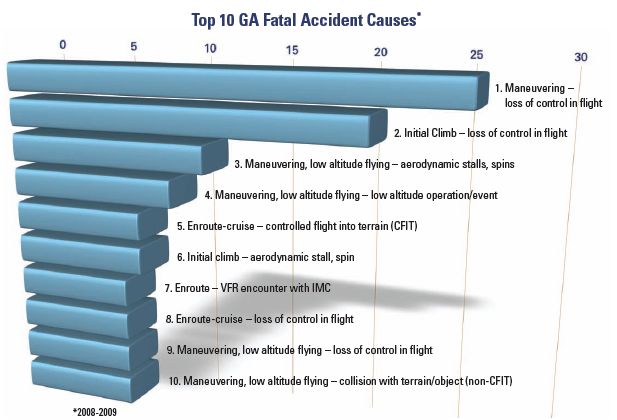Top 10 Signs You (or Your Airplane) May Be in Trouble
By Tom Hoffmann
Reprinted with permission from FAA Safety Briefing
Top 10 lists: They are featured in late-night television jokes, rank the year’s best movies, and even suggest the most influential minds among us. Just about everyone can appreciate a good top 10 list, even if only for entertainment value. But in the world of aviation, top 10 lists play a much more vital role. They help save lives.
Just ask Natalie Johnston, aviation safety analyst with the FAA’s Office of Accident Investigation and Prevention, who’s researching a list of particular interest to pilots—the top 10 causes of general aviation fatal accidents. With the help of several GA subject matter experts (SME), including FAA representatives from maintenance, operations, and the FAASTeam, Johnston is compiling a comprehensive list of contributing factors for each of these top 10 fatal accident causes. The goal of the list: Help us all understand why accidents happen, and more importantly, help us develop ways to prevent them.
A Fresh Perspective
“We’re looking at information from all angles to dig deeper into the root causes of GA accidents,” says Johnston, who along with the team of experts is reviewing data and narratives from hundreds of NTSB accident reports, and may, in the future, use data from the NASA Aviation Safety Reporting System (ASRS) and the FAASTeam. “Carefully examining the data sources, combined with the operational knowledge and personal experience of our SME team, helps us gain a distinct perspective on how to create a safer environment for the GA community.”
For example, when reviewing an accident report on a pilot who lost control on landing during a stiff crosswind, there are several initial conclusions that can be drawn. Perhaps the pilot lacked training in crosswind landings or was flying an aircraft type different than what he/she normally flies. However, upon further review, you may learn that the pilot failed to get an adequate weather briefing and missed an opportunity to reassess landing options. Or, you may find that the pilot had been flying the final leg of 400-mile journey with dusk’s hazy onset fueling an already safety-jeopardizing fatigue scenario.
Developing an accurate picture of contributing factors for an accident takes a collective effort. By carefully analyzing all possible factors in an accident and by holding them up to the light of firsthand experience and knowledge, it becomes clearer to see the beginning of a particular accident chain.
There’s also the matter of ranking contributing factors. What sets the SME team’s research apart from the way existing accident data is reported is how the team carefully identifies and scores the most common contributing factors for each top GA fatal accident cause. The scoring process is not intended to attribute a specific number to each factor, but rather to distinguish and separate the most important factors from those with the least probability of occurring. “In the end,” says Johnston, “this will help us develop more effective mitigation strategies and pinpoint what pilots need to focus on to keep from being a statistic.”
The Envelope, Please
While the final list of contributing factors is still being completed, here are the top 10 causes for GA fatal accidents as identified from NTSB accident-report data.
1. Maneuvering – loss of control in flight
2. Initial Climb – loss of control in flight
3. Maneuvering, low altitude flying – aerodynamic stalls, spins
4. Maneuvering, low altitude flying – low altitude operation/event
5. Enroute-cruise – controlled flight into terrain (CFIT)
6. Initial climb – aerodynamic stall, spin
7. Enroute – VFR encounter with IMC
8. Enroute-cruise – loss of control in flight
9. Maneuvering, low altitude flying – loss of control in flight
10. Maneuvering, low altitude flying – collision with terrain/object (non-CFIT)

Looking at the top two, there is a common thread: loss of control in flight. “When we studied loss-of-control accidents, during both the maneuvering and initial-climb phase, the top contributing factor was failure to maintain airspeed,” says FAA Aviation Safety Inspector Donald Wood. A member of the SME team, Wood was somewhat surprised by the finding. “What this shows is a definite need for improving basic ‘stick and rudder’ skills, even among more experienced pilots.”
Despite a few surprises, the group’s findings are consistent with expectations and reveal important links in the GA accident-prevention chain. Airspeed control, pilot experience, preflight planning, and unusual-attitude recovery are all contributing factors that appear most frequently.
“By exploring these factors in more detail, we are seeing patterns that become helpful clues for pilots in similar situations,” says Mel Cintron, manager of FAA’s General Aviation and Commercial Division. “We look forward to collaborating with industry to review this data, along with data from the AOPA Air Safety Institute’s well-established Nall Report. Our goal is to advance GA safety without stifling the spirit of aviation.”
You will hear more about new safety initiatives in these pages and at the FAASTeam Safety Stand down on April 2, 2011. Mark your calendar and stay tuned for more information on GA accident causes, contributing factors, and, most importantly, prevention strategies.
Tom Hoffmann is associate editor of FAA Safety Briefing. He is a commercial pilot and holds an A&P certificate. |